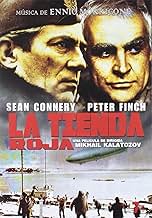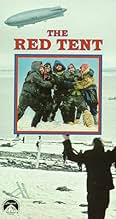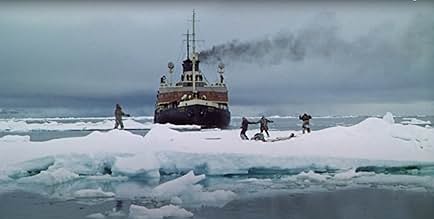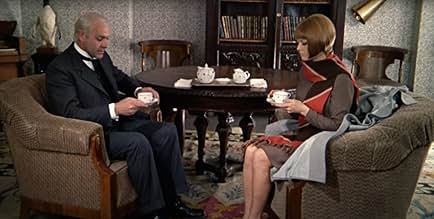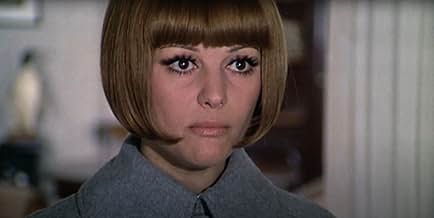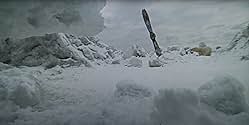Devastato dal senso di colpa, il generale italiano Umberto Nobile ricorda la sua fallita spedizione artica del 1928 a bordo del dirigibile Italia.Devastato dal senso di colpa, il generale italiano Umberto Nobile ricorda la sua fallita spedizione artica del 1928 a bordo del dirigibile Italia.Devastato dal senso di colpa, il generale italiano Umberto Nobile ricorda la sua fallita spedizione artica del 1928 a bordo del dirigibile Italia.
- Regia
- Sceneggiatura
- Star
- Premi
- 2 candidature totali
- Einar Lundborg
- (as Hardy Kruger)
- Renato Alessandrini
- (non citato nei titoli originali)
Recensioni in evidenza
The film is not condescending in that there is a genuine awe and respect for the great polar explorers. Roald Amundsen's spectral presence (played by Sean Connery) is magnetic and haunting.
Another cinematic precursor of this one may be Battle of the River Plate (1956), also starring Peter Finch, a film fascinated with the concept of historical spectacle. The actual crash is a matter of history, indicated at the start of the film and is not a spoiler. The filming of the crash is spectacular and crazy glorious cine-trauma.
Finn Malmgren is one of the most interesting characters, he has a death wish, a love of the emptiness and Arctic loneliness. I think maybe it's something that they all share. Why would anyone venture into this morass of crumbling ice otherwise?
The film is framed by a trial, Nobile trying himself, in his mind, for the disaster, this is very trippy.
That's a pity because photographically it's one of the finest things ever put on celluloid stock. There are some absolutely breathtaking shots of the frozen tundra and the performances of the actors battling the elements are first rate. Maybe a straight narrative might have been better instead of having the aged Nobile confronting some angry spirits of the past. Nobile was still alive when this film came out, he would die in 1978 still a figure of controversy. The dream with the angry spirits is a device frankly ripped off from George Bernard Shaw's St. Joan.
Maybe the film could be best compared to William Wellman's Island in the Sky that starred John Wayne. The fictional characters there are mostly rescued and held together by Duke's leadership. Of course some thirty years advance in aviation and no political interference helped Wayne's men. And Island in the Sky is a work of fiction.
Maybe it wouldn't be so if men of science could simply be men of science without answering to competing ideologies. Nobile and his men got caught up in the politics of the time. Politics claimed a lot of their lives and the lives of Roald Amundsen and party who vanished in a rescue attempt.
Nobile also made some bad choices and had some bad choices forced on him by Mussolini's fascist government. He was also a man out of his element, he was great aviation pioneer, but not a polar explorer. He paid with his reputation, some of his party paid with their lives.
Sean Connery has a small role as Roald Amundsen and I wish we had more of him here. Finch has a very effective scene with Claudia Cardinale the widow of one of his men where she takes him to task. Hardy Kruger does a fine job as the aviator presenting Finch with a very disagreeable choice.
I'd recommend seeing it, but only on the big screen. Or definitely in a letter box version. The formatted VHS I have definitely hampers the spectacle.
The entire film actually takes place in the General's mind. He calls back various participants to the event, to re-live what happened, and ultimately to pass judgment on him. It is this framing device that makes the film unique, for it examines Nobile's leadership from a divergent points of view, allowing the viewers to make their own judgment as well. It is a theatrical device to be sure, but it works in this film. In time we come to learn that truth often walks on two legs and has a left and right hand. "Yet we must have judgment", says one of the participants, and so they do. These scenes which all take place in Nobile's apartment in Rome with it's warmth and comfort, provide a wonderful contrast to the stark reality of the struggle for survival at the Arctic Pole.
The film is beautifully written and the acting is of a high level throughout. Sean Connery, ridding himself of his Bond image, plays Roald Amundsen, the great Arctic explorer at the end of his days. It is Amundsen who exemplifies the qualities a great leader should have. It is the first and in some ways still the best of Connery's wise old man performances. He is also the one participant Nobile has most conspicuously not brought back. After intruding on the proceedings like some force of nature, he describes how he had reached the wreak of the Italia, only to crash land and be stranded. With nothing to do but wait to freeze to death he finds solace in his final moments of life with a book he has found strewn among the wreckage. The cynical Lundborg scornfully rejects this "final touch" as "theatrical" "But who would I be acting for?" Amundsen asks. "Yourself" Lundborg replies. "But that isn't acting," Connery wisely replies, "That's necessary. The trick is to choose the right part." The film is filled with great lines like this. Claudia Cardinale, as Nurse Valaria, provides the emotional center of the film. She resents the good people of King's Bay capitalizing on the disaster, yet she has no misgivings whatever in playing on Amundsen's sense of guilt to get him to mount a rescue attempt. After all he had introduced her lover, the Meteorologist, Finn Malgrem to Arctic exploration. She is also willing to offer herself to Lundborg if he will risk his life to fly in unsafe weather conditions. It is her bitter confrontation with Nobile after he has been safely brought back to King's Bay while the others were left freezing on the ice, that is the beginning of his sleepless nights. His inability to stop Zampi, his ambitious second in command from leaving the red tent with Mariano and Malgrem in a vain attempt to reach help, would result in the Meteorologist being lost on the ice. "You cracked like the ice." she tells the General. "We shall never meet again I hope. And I hope you never forget." He doesn't.
Peter Finch as Nobile carries the film, and he is in every way up to the task. He manages to convey the intelligence, courage, vanity and despair of this self-doubting individual. He is a man who both admires Amundsen and resents always being compared with him. Hardy Kruger plays the dashing Aviator Lundborg with a nice blend of charm and hard edge cynicism. He is the first to reach the survivors. His motives for rescuing the Nobile over the General's objections that he take the other members of his expedition first, some of whom are badly injured, may have been less than admirable, but it is this act that will ultimately save the others. Lundborg finally persuades the General to go with a combination of threats,(he will leave him and the others behind), reassurance,(six quick trips and it will be over), and finally reason, (the General is badly needed at King's Bay to organize the rescue). The others also agree the General must go. It is only when he is safely back at King's Bay, that he realizes his actions have been badly misconstrued as an act of desertion. By that time weather conditions have changed again and it is impossible to go back and rescue the others by air. "What do they think I've done?" he asks Captain Romagna, the ineffectual rescue coordinator, after reading a cable from Rome placing him under arrest. "They think you have done what you have done, I suppose." Romagna lamely replies. While aboard ship, Nobile radios his friend Samoilovitch to use the icebreaker Krassin to rescue the others. This he does. "Men are judged by their actions and their actions by their success." The General's decision to leave his men led to his being able to radio the Krassin which in turn led to the rescue of his men. "His actions, therefor were correct."
Lastly, Ennio Morricone's lush score captures both the romance of a great endeavor being undertaken and the desolate, ethereal beauty of the Arctic. This film deserves to be seen and heard, and one can only hope that one day it will be restored.
Lo sapevi?
- QuizSir Sean Connery, who received top billing, spent three weeks filming in Moscow. Peter Finch spent nine months on the production.
- BlooperDuring the final break up of the pack-ice, many shots are included that in fact depict the calving of icebergs at a glacier snout or edge of an ice-shelf. Pack-ice breaking up and icebergs calving are completely unlike each other visually - and, as physical phenomena, are entirely unrelated.
- Citazioni
Aviator Lundborg: Men are risking their necks for fame, a medal, promotion, or money. What's wrong with money, mm? Just a means to happiness.
Roald Amundsen: But you don't look like a happy man, exactly. More like a man who's learned to be indifferent to unhappiness.
Aviator Lundborg: I'm glad you know it all, Mr. Amundsen.
Roald Amundsen: But you see, a man who is indifferent to his own unhappiness is indifferent to everything.
- Curiosità sui creditiSome of the material for the Russian version listed the Scottish actor who plays Amundsen as "Sh. Konneri."
- Versioni alternativeThe version released in the Soviet Union was significantly longer and featured an alternate score by composer Aleksandr Zatsepin instead of the score by Ennio Morricone used in the shorter European/American version.
- ConnessioniFeatured in Film o Mikhail Konstantinovich Kalatozov v Dvukh Chasmyakh (2006)
I più visti
- How long is The Red Tent?Powered by Alexa
Dettagli
Botteghino
- Budget
- 10.000.000 USD (previsto)
- Tempo di esecuzione
- 2h 38min(158 min)
- Proporzioni
- 2.20 : 1

